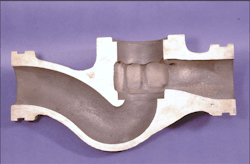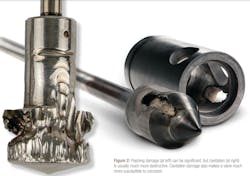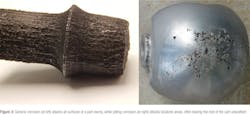Valve material selection can be likened to fighting the mythical hydra. You focus on one head and think you have it beaten, and then suddenly, you are being attacked by two others. The problem is multifaceted because there are often several different physical and chemical processes at play. In addition, each valve component may have a different set of critical property requirements.
However, it is important to note that the mechanisms that cause valve components to degrade are complex and interconnected. While this discussion provides general guidance and strives to increase awareness of the various factors involved in material selection, each process and product needs to be thoroughly reviewed and understood to select the best material.
Understand the challenges
The first step in fighting a dragon is to identify which monster to face first, and this can be the most difficult part of the material selection process. There are many reasons for control valve component degradation, including erosion, adhesive wear, flashing, cavitation, corrosion, temperature extremes, and others. Several of these challenges often occur simultaneously, so it is important to identify and understand each problem.
Erosion (Figure 1) is the physical removal of material from a part due to particulate in the process fluid. This effect is common with slurries or liquids carrying abrasive particles, and it is usually countered by using hard materials or high strength coatings.
Despite the misleading name, adhesive wear is not related to aggressive glue, but results when metals rub against each other. This can be particularly troublesome for high cycle valves that must operate continuously for long periods of time. The key to addressing this problem is selecting the right combination of materials so they do not damage each other. Different materials have varying predispositions for galling — another name for adhesive wear — but there are some general guiding principles. Two soft materials in contact tend to gall, but a hard material paired with a relatively soft material will last much longer.
Flashing damage (Figure 2, left) occurs when a liquid passes through a valve and the downstream pressure is below the vapor pressure of the liquid. The liquid effectively boils as it moves through the throat of the valve, wearing metal in the process. Cavitation (Figure 2, right) is similar to flashing but is usually much more destructive. In this case, the liquid drops below the vapor pressure as it goes through the valve, but then the pressure rises, collapsing the bubbles. The resulting microjets and shock waves strike the valve walls, trim and downstream piping, inflicting damage.
Flashing, and particularly cavitation, are fearsome foes indeed. The tools to combat these phenomena are a combination of very hard materials to minimize the rate of damage and/or a valve trim design to either eliminate the cavitation or focus the destructive energy away from sensitive valve components. In cases of severe and unavoidable cavitation, one cannot win, but only slow the effect and buy time. Eventually, the valve will be damaged and require repair.
Corrosion is another vicious adversary, which comes in many forms and is chemically induced (Figure 3). General corrosion is one of the most common and easily understood forms of corrosion. It occurs when an environment attacks a metal uniformly, such as the rusting of steel or iron that is left unprotected outdoors. Unlike general corrosion, pitting corrosion is a localized attack that leaves deep pits in metal that might otherwise be unaffected.
The list of corrosion types goes on and on, including stress corrosion cracking (SCC), crevice corrosion, intergranular corrosion, galvanic corrosion and many others. The hardest part of battling corrosion is understanding what chemical process is in play because, in many instances, there are several types of corrosion occurring simultaneously.
Identify goals
Having identified the adversary, it is time to define primary goals for material selection. Some of the typical material properties include strength, wear resistance, thermal expansion, corrosion resistance and creep resistance. The critical material properties vary significantly and depend on the valve component being considered (Figure 4).
Strength (or hardness) is a measure of how a material resists cutting, scratching or bending. Wear resistance indicates how well a material absorbs energy and avoids fracture or damage. Thermal expansion and corrosion resistance are self-explanatory, but the concept of “creep” is less common. Creep resistance is a solid material’s ability to avoid slowly deforming over long periods of stress while exposed to high temperatures. The best material for a particular application depends on how that component is being used in the valve, and this is why different valve components are often fabricated from varying materials.
Know your materials
Now that you have identified your adversary and know your goals, it is time to consider the array of arrows available in your quiver. The number of materials is expansive, and the breadth of proprietary and generic names often leads to confusion. For instance, “Hastelloy” is a common trade name, but there are over 20 versions of Hastelloy metals. There are at least six different alloys that are called Inconel. When referring to alloys, it is often best to use the generic names such as a UNS number or ASTM standard when possible to avoid confusion.
It is also important to understand how a particular metal protects against corrosion. Some materials employ passive corrosion resistance by forming a protective oxide layer which resists continued attack. Examples are stainless steel (SST), C-276 Hastelloy C and titanium. These materials tend to work well in oxidizing environments but work poorly in reducing environments, which attack the oxide layer. Other materials are more inert and do not readily react in many environments or do not rely as strongly on an oxide layer for protection. Examples of these materials include Monel, gold and Hastelloy B-3.
The Figure 5 table lists a variety of materials and their various strengths and weaknesses. It is important to note that this is an abbreviated list and only meant to illustrate the varying capabilities of the various material groups. This table should not be used as a guide for material selection.
Clearly, the number of options is huge, and the price differential from one alloy to another can be significant. When faced with a difficult material selection decision, it is advisable to discuss the options with your valve vendor. Often, several alloys may work, and the best choice for your particular application may be a combination of valve design and valve component material selection.
Conclusion
When faced with a difficult valve application, it is important to carefully and fully evaluate the situation to understand exactly what issues are at play. Often, there is a combination of physical processes (erosion, cavitation, etc.), as well as one or more corrosive processes, and it takes a complete understanding of the whole picture to fully address the problem. Once armed with that information, users can work with control valve vendors to select the best combination of valve design and component materials of construction to provide reliable, long-term service.
Fighting the hydra of material selection does not have to be a herculean effort when one is forearmed with process knowledge and has strong technical support in their corner. Using these skills, designers can solve vexing control valve headaches in their plant and become a process hero in no time.
Brett Hofman is an additive materials engineer for Emerson, researching how to realize the potential of additive manufacturing technologies in Emerson’s products. He previously held the role of materials engineer for Emerson’s flow control products, providing materials technical support on a global level to various departments across the company. He graduated from Iowa State University with Bachelor of Science in materials engineering in 2016.
Emerson
About the Author
Brett Hofman
Brett Hofman is an additive materials engineer for Emerson, researching how to realize the potential of additive manufacturing technologies in Emerson’s products. He previously held the role of materials engineer for Emerson’s flow control products, providing materials technical support on a global level to various departments across the company. He graduated from Iowa State University with Bachelor of Science in materials engineering in 2016.




